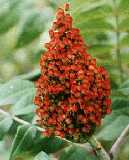 RED SUMAC: ID, Names Info
RED SUMAC: ID, Names InfoJump to Page Navigation Buttons===>>
 |
Smooth or Red sumac around the Great Lakes area grows in clumps of wide-spreading shrubby plants, like this one, whose bloom head is just beginning to turn to a spike of berries that will be covered by a reddish haze of fine hairs. The Ojibwe name for this plant is Makibug. Its botannical name is Rhus glabra, meaning smooth-barked sumac. |
|---|---|
The red berries contain hard seeds. The main attraction is the hairs that cover them. These are loaded with ascorbic acid -- vitamin C. The fruit holds some, too, as well as some tannin, the astringent that's in ordinary tea. |
 |
Pick the whole head, and if you have access to an old wringer washer whose paddle still works, slosh them around for half an hour in cold water (after rinsing tub and paddles to make sure there's no soap on them!), and catch the pink tart juice pumped out Otherwise, pound the heads in water in a big tub or dishpan. Refrigerate or freeze the juice and sweeten with sugar or honey. The berries can be dried and removed from the stems -- do this over a plastic sheet to catch all the little hairs. Dried or fresh, the berries need to be pounded in water to yield up their vitamin C, flavor, and red color. | |
 Red sumac doesn't get its name from its colorful berry spike, but from the way its leaves change to bright red well ahead of most fall foliage. Here a cluster of them is in a Wisconsin woodland, getting the jump on autumn at summer's end. Red sumac doesn't get its name from its colorful berry spike, but from the way its leaves change to bright red well ahead of most fall foliage. Here a cluster of them is in a Wisconsin woodland, getting the jump on autumn at summer's end. |
|
 Sumac doesn't grow only as a shrubby bush, as it does around here. In warmer areas, on low foothills, it grows into a slender-trunked, attractive tree. This one was photographed somewhere in the southwest, apparently at night, one of what appears to be a group of them. Sumac doesn't grow only as a shrubby bush, as it does around here. In warmer areas, on low foothills, it grows into a slender-trunked, attractive tree. This one was photographed somewhere in the southwest, apparently at night, one of what appears to be a group of them. |
|

Multi-tribal uses of Sumac tabulated in an active table from AGIS. By clicking on a tree or tribe, find out more by references to written reports. Note that almost all the Iroquois uses -- the ones Katsi refers to but doesn't say much about -- come from one man's 1977 PhD thsis, and do not give any direct connections to tribal informants.
Phytochemical analysis for Red Sumac from the AGIS database is quite disappointing, since it does not show much nutrient content (we know from other sources that Vitamin C is very high), and does not appear motivated by much interest in the berries, which were widely used as a dependable source of a vitamin C-rich winter drink, and later used by native women in making jams, jellies and pies that needed a sharpened, acidic taste. You don't have to buy lemons in a non-money economy if you have a supply of red sumac berries to make a sharp-tasting juice of.

 Plants Plants MENU |
|---|

CREDITS: The red sumac photos are from the University of Wisconsin (Madison) botany gopher. The sumac tree was photographed by Michael Moore, editor of Herbalgram published by the American Botanical Council, and maintainer of the Herb Research Foundation's web page. Moore teaches classes in natural plant medicines, and is the author of several books on medicinal plants of the desert, mountains, and Pacific coastal areas.
Webmistress --Paula Giese.Text and graphics copyright 1996.
Last Updated: Tuesday, January 16, 1996 - 5:44:15 AM